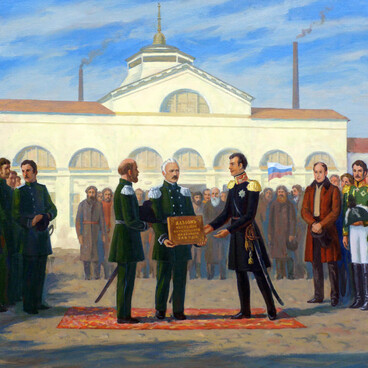The abacus is a simple tool for arithmetic calculations. Russian abaci use decimal counting system. Each row of beads represents a numerical rank, which increases from singles to hundreds of thousands upward from a spoke with four beads, and decreases from tenths to thousandths downward. The spoke with four beads separates the integer parts of the number from the fractions; integers are located above it, and fractions are below it.
To ‘create’ a number, the beads are moved from the right end of the spoke to the left. This layout allows for easy accounting of money with quarters (such as 25 kopecks). Central beads are painted black for convenience. The abacus currently displayed in the museum exhibition was found at the demolition site in Izhevsk in the 1980s.
The first abacus-type devices appeared, presumably, in Ancient Babylon around the 3rd millennium BC. These devices comprised a board with grooves or indentations that formed a horizontal grid. Counting tokens—stones or beads—were moved along the lines or grooves. The device itself is called ‘the abacus’ after the counting board used for arithmetic calculations in Ancient Greece and Ancient Rome from about the 4th century BC. The abacus was used in Europe until the 18th century. The Chinese analog of the abacus—Xuanpan—is common among eastern nations.
The first known mention of the abacus in Russia is found in the 1658 ‘Accounting book of Patriarch Nikon’s house treasury, ’ where the device is called “schoty.” The item comprised a frame with 12 spokes, with 10 beads on every spoke.
A new version of the Russian abacus, which has survived to this day, was proposed by mathematician Alexander Bolman in 1860. He manufactured an abacus with nine beads in each full row. One could raise to a power, extract roots, calculate compound interest, and perform four arithmetic operations on his abacus.
The abacus is one of the earliest calculating devices which was widely used in trade and accounting up until the second half of the 20th century, whereupon they were replaced by calculators.
To ‘create’ a number, the beads are moved from the right end of the spoke to the left. This layout allows for easy accounting of money with quarters (such as 25 kopecks). Central beads are painted black for convenience. The abacus currently displayed in the museum exhibition was found at the demolition site in Izhevsk in the 1980s.
The first abacus-type devices appeared, presumably, in Ancient Babylon around the 3rd millennium BC. These devices comprised a board with grooves or indentations that formed a horizontal grid. Counting tokens—stones or beads—were moved along the lines or grooves. The device itself is called ‘the abacus’ after the counting board used for arithmetic calculations in Ancient Greece and Ancient Rome from about the 4th century BC. The abacus was used in Europe until the 18th century. The Chinese analog of the abacus—Xuanpan—is common among eastern nations.
The first known mention of the abacus in Russia is found in the 1658 ‘Accounting book of Patriarch Nikon’s house treasury, ’ where the device is called “schoty.” The item comprised a frame with 12 spokes, with 10 beads on every spoke.
A new version of the Russian abacus, which has survived to this day, was proposed by mathematician Alexander Bolman in 1860. He manufactured an abacus with nine beads in each full row. One could raise to a power, extract roots, calculate compound interest, and perform four arithmetic operations on his abacus.
The abacus is one of the earliest calculating devices which was widely used in trade and accounting up until the second half of the 20th century, whereupon they were replaced by calculators.



